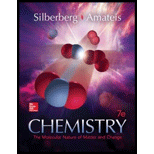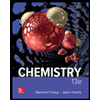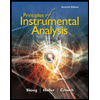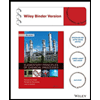
Chemistry: The Molecular Nature of Matter and Change - Standalone book
7th Edition
ISBN: 9780073511177
Author: Martin Silberberg Dr., Patricia Amateis Professor
Publisher: McGraw-Hill Education
expand_more
expand_more
format_list_bulleted
Question
Chapter 21.4, Problem 21.6AFP
Interpretation Introduction
Interpretation:
For given
Concept Introduction:
The Standard Gibb’s free energy change and the standard cell potential are related as followed:
The relationship between equilibrium constant and the standard cell potential is as follows,
Expert Solution & Answer
Want to see the full answer?
Check out a sample textbook solution
Students have asked these similar questions
A chemical engineer is studying the two reactions shown in the table below.
In each case, she fills a reaction vessel with some mixture of the reactants and products at a constant temperature of 70.0 °C and constant total pressure.
Then, she measures the reaction enthalpy AH and reaction entropy AS of the first reaction, and the reaction enthalpy AH and reaction free energy AG of the
second reaction. The results of her measurements are shown in the table.
Complete the table. That is, calculate AG for the first reaction and AS for the second. (Round your answer to zero decimal places.) Then, decide whether, under
the conditions the engineer has set up, the reaction is spontaneous, the reverse reaction is spontaneous, or neither forward nor reverse reaction is spontaneous
because the system is at equilibrium.
-
P₁ (s) + 20HF (g). 4PF, (g) + 10H2(g)
AH-1005. kJ
J
AS 2929.
K
AG =
0 kJ
Which is spontaneous?
this reaction
the reverse reaction
neither
AH = 12. kJ
+0=
AS =
SnO2 (s) + 2CO(g) →…
A chemist fills a reaction vessel with 0.281 g silver chromate (Ag₂CrO4) solid, 0.710 M silver (Ag*) aqueous solution, and 0.985 M chromate (CrO2-)
aqueous solution at a temperature of 25.0°C.
Under these conditions, calculate the reaction free energy AG for the following chemical reaction:
Ag2CrO4(s) 2Ag(aq) + CrO4(aq)
Use the thermodynamic information in the ALEKS Data tab. Round your answer to the nearest kilojoule.
4
☐ kJ
x
Draw the structure corresponding to each IUPAC name.
Part 1 of 2
A skeletal structure corresponding to the IUPAC name 3-ethylhexane.
Click and drag to start drawing a
structure.
Chapter 21 Solutions
Chemistry: The Molecular Nature of Matter and Change - Standalone book
Ch. 21.1 - Write a balanced molecular equation for the...Ch. 21.1 - Prob. 21.1BFPCh. 21.2 - In one half-cell of a voltaic cell, a graphite rod...Ch. 21.2 - In one half-cell of a voltaic cell, a graphite rod...Ch. 21.3 - Prob. 21.3AFPCh. 21.3 - Prob. 21.3BFPCh. 21.3 - Prob. 21.4AFPCh. 21.3 - Prob. 21.4BFPCh. 21.3 -
Combine pairs of the balanced half-reactions (1),...Ch. 21.3 - Prob. 21.5BFP
Ch. 21.4 - Prob. 21.6AFPCh. 21.4 - Prob. 21.6BFPCh. 21.4 - Prob. 21.7AFPCh. 21.4 - Prob. 21.7BFPCh. 21.4 - Prob. 21.8AFPCh. 21.4 - Prob. 21.8BFPCh. 21.7 - The most ionic and least ionic of the common...Ch. 21.7 - Prob. 21.9BFPCh. 21.7 - Prob. 21.10AFPCh. 21.7 - Prob. 21.10BFPCh. 21.7 - Prob. 21.11AFPCh. 21.7 - Prob. 21.11BFPCh. 21.7 - In the final steps of the ETC, iron and copper...Ch. 21.7 - Prob. B21.2PCh. 21 - Prob. 21.1PCh. 21 - Prob. 21.2PCh. 21 - Prob. 21.3PCh. 21 - Water is used to balance O atoms in the...Ch. 21 - Prob. 21.5PCh. 21 - Prob. 21.6PCh. 21 - Prob. 21.7PCh. 21 - Prob. 21.8PCh. 21 - Prob. 21.9PCh. 21 - Prob. 21.10PCh. 21 - Prob. 21.11PCh. 21 - Prob. 21.12PCh. 21 - Prob. 21.13PCh. 21 - Prob. 21.14PCh. 21 - Prob. 21.15PCh. 21 - Prob. 21.16PCh. 21 - Prob. 21.17PCh. 21 - Prob. 21.18PCh. 21 - Prob. 21.19PCh. 21 - Prob. 21.20PCh. 21 - Aqua regia, a mixture of concentrated HNO3 and...Ch. 21 - Consider the following general voltaic...Ch. 21 - Why does a voltaic cell not operate unless the two...Ch. 21 - Prob. 21.24PCh. 21 - Prob. 21.25PCh. 21 - Prob. 21.26PCh. 21 - Consider the following voltaic cell:
In which...Ch. 21 - Consider the following voltaic cell:
In which...Ch. 21 - Prob. 21.29PCh. 21 - Prob. 21.30PCh. 21 - A voltaic cell is constructed with an Fe/Fe2+...Ch. 21 - Prob. 21.32PCh. 21 - Prob. 21.33PCh. 21 - Prob. 21.34PCh. 21 - Prob. 21.35PCh. 21 - What does a negative indicate about a redox...Ch. 21 - Prob. 21.37PCh. 21 - In basic solution, Se2− and ions react...Ch. 21 - Prob. 21.39PCh. 21 - Prob. 21.40PCh. 21 - Use the emf series (Appendix D) to arrange each...Ch. 21 - Prob. 21.42PCh. 21 - Prob. 21.43PCh. 21 - Prob. 21.44PCh. 21 - Prob. 21.45PCh. 21 - Prob. 21.46PCh. 21 - Prob. 21.47PCh. 21 - Prob. 21.48PCh. 21 - Prob. 21.49PCh. 21 - Prob. 21.50PCh. 21 - Prob. 21.51PCh. 21 - Prob. 21.52PCh. 21 - Prob. 21.53PCh. 21 - Prob. 21.54PCh. 21 - Prob. 21.55PCh. 21 - Prob. 21.56PCh. 21 - Prob. 21.57PCh. 21 - Prob. 21.58PCh. 21 - Prob. 21.59PCh. 21 - Prob. 21.60PCh. 21 - Prob. 21.61PCh. 21 - Prob. 21.62PCh. 21 - Prob. 21.63PCh. 21 - Prob. 21.64PCh. 21 - Prob. 21.65PCh. 21 - Prob. 21.66PCh. 21 - Prob. 21.67PCh. 21 - Prob. 21.68PCh. 21 - Prob. 21.69PCh. 21 - Prob. 21.70PCh. 21 - Prob. 21.71PCh. 21 - Prob. 21.72PCh. 21 - Prob. 21.73PCh. 21 - Prob. 21.74PCh. 21 - Prob. 21.75PCh. 21 - Prob. 21.76PCh. 21 - Prob. 21.77PCh. 21 - Prob. 21.78PCh. 21 - Prob. 21.79PCh. 21 - Prob. 21.80PCh. 21 - Prob. 21.81PCh. 21 - Consider the following general electrolytic...Ch. 21 - Prob. 21.83PCh. 21 - Prob. 21.84PCh. 21 - Prob. 21.85PCh. 21 - Prob. 21.86PCh. 21 - In the electrolysis of molten NaBr:
What product...Ch. 21 - Prob. 21.88PCh. 21 - Prob. 21.89PCh. 21 - Prob. 21.90PCh. 21 - Prob. 21.91PCh. 21 - Prob. 21.92PCh. 21 - Prob. 21.93PCh. 21 - Prob. 21.94PCh. 21 - Prob. 21.95PCh. 21 - Prob. 21.96PCh. 21 - Prob. 21.97PCh. 21 - Write a balanced half-reaction for the product...Ch. 21 - Prob. 21.99PCh. 21 - Prob. 21.100PCh. 21 - Prob. 21.101PCh. 21 - Prob. 21.102PCh. 21 - Prob. 21.103PCh. 21 - Prob. 21.104PCh. 21 - Prob. 21.105PCh. 21 - Prob. 21.106PCh. 21 - Prob. 21.107PCh. 21 - Prob. 21.108PCh. 21 - Prob. 21.109PCh. 21 - Prob. 21.110PCh. 21 - Prob. 21.111PCh. 21 - Prob. 21.112PCh. 21 - Prob. 21.113PCh. 21 - Prob. 21.114PCh. 21 - Prob. 21.115PCh. 21 - Prob. 21.116PCh. 21 - Prob. 21.117PCh. 21 - Prob. 21.118PCh. 21 - Prob. 21.119PCh. 21 - Prob. 21.120PCh. 21 - To examine the effect of ion removal on cell...Ch. 21 - Prob. 21.122PCh. 21 - Prob. 21.123PCh. 21 - Prob. 21.124PCh. 21 - Prob. 21.125PCh. 21 - Prob. 21.126PCh. 21 - Commercial electrolytic cells for producing...Ch. 21 - Prob. 21.129PCh. 21 - Prob. 21.130PCh. 21 - The following reactions are used in...Ch. 21 - Prob. 21.132PCh. 21 - Prob. 21.133PCh. 21 - Prob. 21.134PCh. 21 - Prob. 21.135PCh. 21 - If the Ecell of the following cell is 0.915 V,...Ch. 21 - Prob. 21.137PCh. 21 - Prob. 21.138PCh. 21 - Prob. 21.139PCh. 21 - Prob. 21.140PCh. 21 - Prob. 21.141PCh. 21 - Prob. 21.142PCh. 21 - Prob. 21.143PCh. 21 - Prob. 21.144PCh. 21 - Prob. 21.145PCh. 21 - Prob. 21.146PCh. 21 - Prob. 21.147PCh. 21 - Both Ti and V are reactive enough to displace H2...Ch. 21 - For the reaction
∆G° = 87.8 kJ/mol
Identity the...Ch. 21 - Two voltaic cells are to be joined so that one...Ch. 21 - Prob. 21.152PCh. 21 - Prob. 21.153P
Knowledge Booster
Learn more about
Need a deep-dive on the concept behind this application? Look no further. Learn more about this topic, chemistry and related others by exploring similar questions and additional content below.Similar questions
- Using any data you can find in the ALEKS Data resource, calculate the equilibrium constant K at 25.0 °C for the following reaction. TiC₁₁(g) + 2H₂O(g) → TiO2 (s) + 4HCl (g) 4 Round your answer to 2 significant digits. K = ☐ x10 D Хarrow_forward: ☐ Х Draw an α amino acid with a hydroxyethyl (-CH2-CH2- OH) side chain. Draw the molecule as it would appear at physiological pH. Click and drag to start drawing a structure. 5 Parrow_forwardDraw the product of the reaction shown below. Ignore inorganic byproducts. cat. H2SO4 HNO3 (1 equiv) Drawing Qarrow_forward
- Provide the correct systematic name for the compound shown here.arrow_forwardUsing the appropriate bond energies, calculate the heat of reaction AH for the following reaction: H-H + CI-CI 2 H-CI You can find a table of bond energies by using the Data button on the ALEKS toolbar. Round your answer to the nearest kJ/mol. Note: For clarity, all lone pairs have been omitted from the molecular structures. ☐ kJ mol ค 000 Ar Barrow_forwardPredict the hydrocarbon, of formula C6H10, needed to prepare the following geminal dibromide upon treatment with excess hydrobromic acid. Note: The shown product is the only regioisomer formed in this reaction. HBr H₂C. CH3arrow_forward
- A mixture of CaCO3 and MgC2O4 of unknown mass was heated in a 0.5 L closed rigid vessel to 900 degrees C.at 400C the following reaction occurs:MgC2O4 -> MgO (s) + CO (g) + CO2 (g)At 700C a second reaction occurs: CaCO3 -> CaO (s) + CO2 (g)The solid mass in the vessel was measured to be 3.06 g at 400C and 2.03g at 900CQuestion: What is the partial pressure of CO in both temperatures? (400 and 900C), provide detailed explanation.arrow_forwardFor the following alkyne, complete the reaction sequentially (that is draw the intermediate that we can’t stop at) and then name (complete name) all 3 molecules.arrow_forwardGiven the reaction sequence below, answer the following. A. Provide the structure for A. B. Provide the structure for B (pay attention to stereochemistry). C. Provide the structure for C. D. What are the stereochemical designations for I and II (R/S)?arrow_forward
arrow_back_ios
SEE MORE QUESTIONS
arrow_forward_ios
Recommended textbooks for you
 ChemistryChemistryISBN:9781305957404Author:Steven S. Zumdahl, Susan A. Zumdahl, Donald J. DeCostePublisher:Cengage Learning
ChemistryChemistryISBN:9781305957404Author:Steven S. Zumdahl, Susan A. Zumdahl, Donald J. DeCostePublisher:Cengage Learning ChemistryChemistryISBN:9781259911156Author:Raymond Chang Dr., Jason Overby ProfessorPublisher:McGraw-Hill Education
ChemistryChemistryISBN:9781259911156Author:Raymond Chang Dr., Jason Overby ProfessorPublisher:McGraw-Hill Education Principles of Instrumental AnalysisChemistryISBN:9781305577213Author:Douglas A. Skoog, F. James Holler, Stanley R. CrouchPublisher:Cengage Learning
Principles of Instrumental AnalysisChemistryISBN:9781305577213Author:Douglas A. Skoog, F. James Holler, Stanley R. CrouchPublisher:Cengage Learning Organic ChemistryChemistryISBN:9780078021558Author:Janice Gorzynski Smith Dr.Publisher:McGraw-Hill Education
Organic ChemistryChemistryISBN:9780078021558Author:Janice Gorzynski Smith Dr.Publisher:McGraw-Hill Education Chemistry: Principles and ReactionsChemistryISBN:9781305079373Author:William L. Masterton, Cecile N. HurleyPublisher:Cengage Learning
Chemistry: Principles and ReactionsChemistryISBN:9781305079373Author:William L. Masterton, Cecile N. HurleyPublisher:Cengage Learning Elementary Principles of Chemical Processes, Bind...ChemistryISBN:9781118431221Author:Richard M. Felder, Ronald W. Rousseau, Lisa G. BullardPublisher:WILEY
Elementary Principles of Chemical Processes, Bind...ChemistryISBN:9781118431221Author:Richard M. Felder, Ronald W. Rousseau, Lisa G. BullardPublisher:WILEY

Chemistry
Chemistry
ISBN:9781305957404
Author:Steven S. Zumdahl, Susan A. Zumdahl, Donald J. DeCoste
Publisher:Cengage Learning

Chemistry
Chemistry
ISBN:9781259911156
Author:Raymond Chang Dr., Jason Overby Professor
Publisher:McGraw-Hill Education

Principles of Instrumental Analysis
Chemistry
ISBN:9781305577213
Author:Douglas A. Skoog, F. James Holler, Stanley R. Crouch
Publisher:Cengage Learning

Organic Chemistry
Chemistry
ISBN:9780078021558
Author:Janice Gorzynski Smith Dr.
Publisher:McGraw-Hill Education

Chemistry: Principles and Reactions
Chemistry
ISBN:9781305079373
Author:William L. Masterton, Cecile N. Hurley
Publisher:Cengage Learning

Elementary Principles of Chemical Processes, Bind...
Chemistry
ISBN:9781118431221
Author:Richard M. Felder, Ronald W. Rousseau, Lisa G. Bullard
Publisher:WILEY
Introduction to Electrochemistry; Author: Tyler DeWitt;https://www.youtube.com/watch?v=teTkvUtW4SA;License: Standard YouTube License, CC-BY